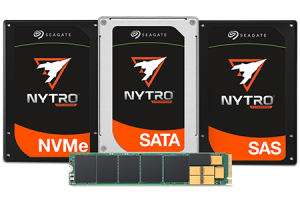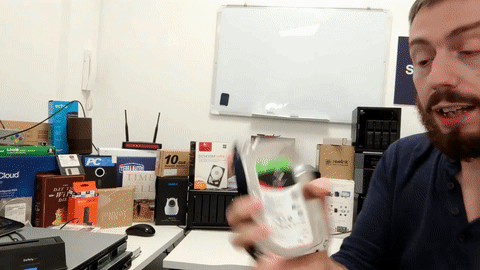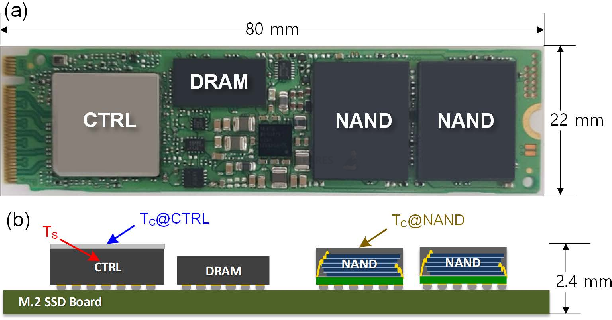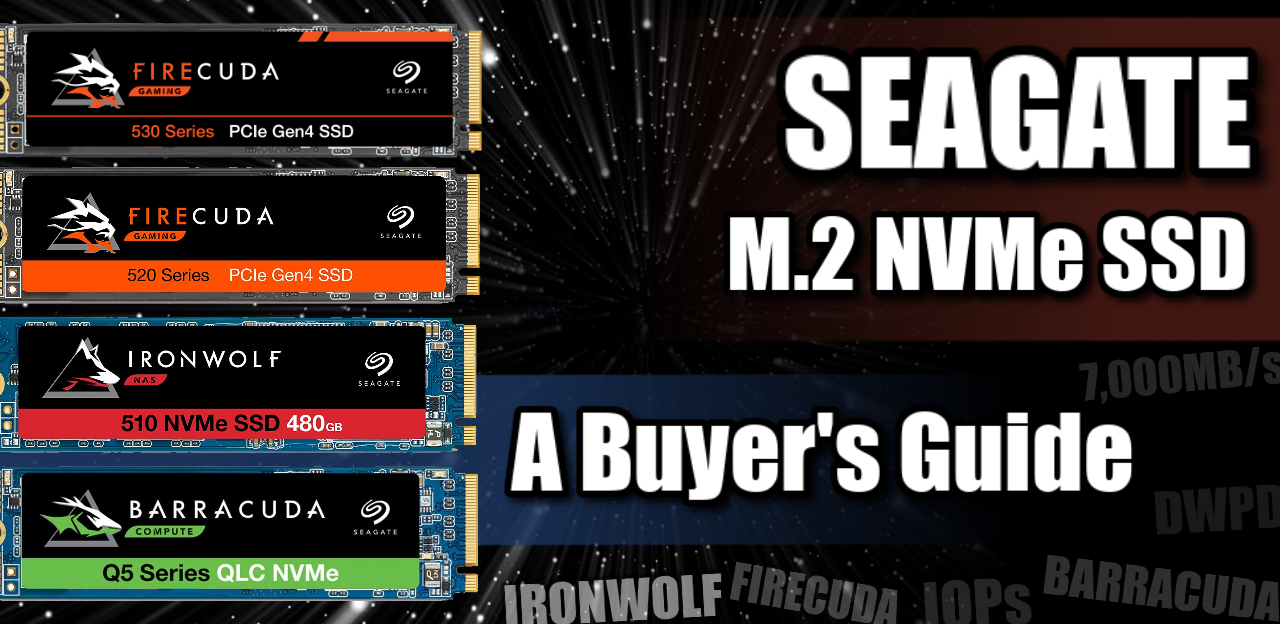Choosing The Right Seagate m.2 SSD – Difference Between Firecuda, Barracuda and Ironwolf
If you are making the move from regularly SATA storage and over to the newest generation of super-fast NVMe SSD, whether it is for gaming, video editing or professional streaming, then you can suddenly be faced with an overwhelming amount of information as you trawl through the remarkably complex world of M.2 PCIe storage drives. Although many brands feature various types of M.2 NVMe media in their portfolios, few have kept things as clearly defined as Seagate. Their SSD range from home, to business and to enterprise, so today I want to go through the current five types of NVMe drive they offer in 2021/2022 and help you decide which one best suits your needs.
IMPORTANT – Remember, this is not strictly about the BEST NVMe SSD (though that is highlighted), this is about helping you which M.2 NVMe best suits YOUR needs, so in some cases, the SSD that is half the price of the others or less enduring, might still be more than suitable for you. Additionally, these are ALL M.2 NVMe SSDs, so NOT SATA M.2s (which cannot exceed 500-600MB/s). So double-check your PC/Laptop/Console supports NVMe M.2 SATA before buying anything! Lastly, ALL of the drives in today’s comparison of NVMes are 2280 in length (though longer and higher capacity 22110 models might have been released later in the year when you are reading this, so check you have a PCIe M.2 NVMe slot that can fit the drive you buy!
Seagate Firecuda, Barracuda and Ironwolf NVMe SSDs – Intended Use
Before going any further though, it is important to understand what each of the Seagate Naming conventions represents. I published a full Seagate SSD Buyers Guide last year (covering their entire range of SSDs), but when it comes to NVMe, their individual series can be detailed as follows:

Seagate Barracuda Q5 & 510 – This is their range of drives for standalone computer use. So, office computers, day to day tasks and your base operating system. They are sturdy, reliable drives that arrive at one of the most affordable tiers and give you fairly standard and performance, durability and endurance. It is worth highlighting that the Barracuda 510 appears to be slowly phasing out and leaving the Barracuda Q5 to be the only NVMe at this tier. Remember that the Q in Q5 represents the use of QLC (Quad Layer Cell) NAND. This will be important later.

Seagate Ironwolf 510 – These are drives that are SPECIFICALLY designed for use in NAS servers and for caching. When the same files on a server/NAS/SAN/etc are accessed continuously by one or more users, one way you can improve performance is to install NVMe SSDs in available slots and the system will automatically move copies of these files (big or very, very small) onto this much higher performing media. However, SSD for this task is recommended to have particularly high endurance (typically measures in DWPD, TBW and MTBF) as data will be VERY frequently refreshed/replaced on these NAS caching NVMes. That is why the Ironwolf 510 NVMes exist. They have a fantastic read speed, but write speeds are much lower (leveraging more in favour of over-provisioning and channeling towards read for even faster cache access)

Seagate Firecuda 510, 520 & 530 – The Firecuda Series is the range that Seagate produced for both gamers and high-end video editors (both live broadcast and post-production). With each generation of new architecture M.2 NVMe on the market, Seagate have released a new revision of their Firecuda Prosumer series, currently in 510 (PCIe Gen 3×4), 520 (PCIe Gen 4×4 high-end controller) and 530 (PCIe Gen 4×4 Premium End controller & NAND). These are the highest tier of M.2 NVMes from Seagate you can get, but you will be paying a premium for this level of storage.

Seagate Nytro – This is Seagate’s premium SSD series for Enterprise. However, at the time of writing, there are no strict m.2 NVMe available in the series. These typically arrive in flash server-class SATA drives, SAS and U.2 interfaces and have some of the highest R/W, IOPS and DWPD ratings than any other SSD in the market. Though, there is every possibility that a Seagate Nytro M.2 NVMe will return in future that rivals the Firedcuda 530 in performance and endurance
Fianlly, it is worth highlighting that all of the Seagate M.2 NVMe’s in today’s buyer’s guide include Rescue Recovery services from Seagate – their included data recovery services. I have covered this in more detail in my review of the Seagate Rescue service last year HERE, but I recommend you check it out, as this is a service ONLY Seagate offer and for that extra layer of recovery chance from accidental deletion, corruption, physical damage beyond your control and more.

So, now you understand the different Seagate SSDs, let’s talk about how each M.2 NVMe compares and help you choose the right one for you.
Seagate Firecuda, Barracuda and Ironwolf NVMe SSDs – Controllers, Bandwidth & NAND
Not all M.2 NVMe are built equal and although the general use of PCIe based m.2 storage has existed in the consumer arena now for 4-5 years, the general standard of hardware has MASSIVELY changed. Each M.2 NVMe available in the Seagate ranges are based on quite different architecture. From smaller changes like the revision of NVMe protocol being used (with each later revision being an improvement over the last), to bigger differences in NAND quality, controller (kind of the CPU of the SSD) and bandwidth of the PCIe architecture the M.2 NVMe uses. Below is a breakdown of how each of these five M.2 NVMes from Seagate compare and although we will go into a little detail on this, later in the guide you will see exactly how these small, component level differences result in massive disparity throughout the line up:
| Seagate Firecuda 530
|
Seagate FireCuda 520
|
Seagate FireCuda 510
|
Seagate IronWolf 510
|
BarraCuda Q5
|
|
| Warranty, Limited (years) | 5+3yr Rescue | 5+3yr Rescue | 5+3yr Rescue | 5+3yr Rescue | 3+1yr Rescue |
| PCIe Gen M.2 | PCIe Gen 4×4 | PCIe Gen 4×4 | PCIe Gen 3×4 | PCIe Gen 3×4 | PCIe Gen 3×4 |
| NVMe Rev | NVMe 1.4 | NVMe 1.3 | NVMe 1.3 | NVMe 1.3 | NVMe 1.3 |
So, the fact that only the Firecuda SSDs are available in PCIe Gen 4×4 should give you a good idea of how and why these are going to be the highest performers later on. The PCIe architecture is based around versions and multiplication. PCIe Gen 3 = 1,000MB/s potential bandwidth and the x4 figure simply multiply that number by four, which means PCIe Gen 3×4 = 4,000MB/s bandwidth. PCIe 4×4 in the Firecuda 520 and 530 is twice the bandwidth at 8,000MB/s, but it is always worth remembering that Bandwidth is a maximum POTENTIAL speed, it is the width of the pipe that data can travel through – it is still up to the SSD to fill this pipe with data (known as throughput and filling it is known as saturation). Likewise, the Firecuda 530 is the only drive here using the latest NVMe revision, as it was only released in summer 2021 shortly after NVMe 1.4 rev was fully available.
| Seagate Firecuda 530
|
Seagate FireCuda 520
|
Seagate FireCuda 510
|
Seagate IronWolf 510
|
BarraCuda Q5
|
|
| NAND Type | 176L 3D NAND | Toshiba 96L TLC | Kioxia BiCS3 64L TLC | Kioxia BiCS3 64L TLC | 3D QLC |
| Controller | E18-PS018 | Phison PS5016-E16 | PS5012-E12DC | PS5012-E12DC | Unknown |
Additionally, it is worth looking at the controllers and NAND used in each drive. With the exception of the affordable barracuda Q5, all the Seagate m.2 NVMes feature 3D TLC (Triple layer NAND) – this is currently the best balance of performance, endurance and capacity you can get in 2021/2022. The Barracuda uses the QLC NAND which means data is crammed in more on each cell, resulting in weaker performance and lesser lifespan (reflected later in all other specifications). Another consideration is the number of laters each NAND cell uses (reflected in the number with L on the end, eg 64L and 96L), as this allows improvements in capacity, throughput and sustainability in the NAND, without sacrificing quality. The higher this number, the better really – though it will make the drive more expensive per GB/TB. As impactful as the NAND is though, the controller featured on these SSD is where it REALLY matters! An SSD much like a computer really and is made up of a controller (like a CPU), DRAM/SD-RAM (like computer memory) and NAND cells (like storage media) and although all of these are important, the controller is incredibly important to keep data moving to the interface/connection with the client device (so, in this case m.2 NVMe) as fast as possible.

Unlike Samsung or WD, Seagate does not use ‘in-house’ controllers and have used the Phison series of controllers in a number of high profile SSDs over the years. The current gold standard in these is the Phison E18-PS5018 and this is featured on the Firecuda 530 (as well as with a few other SSDs from other brands, but with lesser NAND and NVMe revs). Overall, it is clear here in the chats that the Firecuda has the best architecture available, but provides this at quite a high price, so although it absolutely wins things in terms of ROI if your budget can cover it, the best all-round SSDs for price AND hardware are the Firecuda 520 and 510, depending on whether you have PCIe 4 or PCIe 3 m.2 slots available.
Seagate Firecuda, Barracuda and Ironwolf NVMe SSDs – Capacity
For some SSD buyers, the capacity (and ultimately the price per GB/TB) can be a big factor in the purchase of their new M.2 NVMe drive. The different ranges available from Seagate are all largely available in the 500GB, 1TB and 2TB tier (with a rejig mix up on the Ironwolf 510 – which I will touch on in a bit), but there are clearly a couple of exceptions after that. The Firecuda 510 and the Ironwolf 510 are the only drives that are available in 250/240GB, because the former can often be used for the core system drive for Gamer PCs that have one or more M.2 slots to use (at least one will be a PCIe 3X4) and the latter needs to be scalable to a NAS system and the HDDs it already has in a RAID. The Firecuda 520 and 530 are not available in this capacity tier because these premium drives already work at their best with more NAND to play with (as you will be in the performance benchmarks in a bit) and the Barracuda Q5 is already using such cost-effective price vs capacity NAND that a 250GB and 500GB model would be practically the same price ultimately. See below:
| Seagate Firecuda 530
|
Seagate FireCuda 520
|
Seagate FireCuda 510
|
Seagate IronWolf 510
|
BarraCuda Q5
|
|
| 240GB / 250GB | N/A | N/A | ZP250GM3A001 | ZP240NM30011 | N/A |
| 2480GB / 500GB | ZP500GM3A013 | ZP500GM3A002 | ZP500GM3A021 | ZP480NM30011 | ZP500CV3A001 |
| 960GB / 1000GB | ZP1000GM3A013 | ZP1000GM3A002 | ZP1000GM3A011 | ZP960NM30011 | ZP1000CV3A001 |
| 1920GB / 2000GB | ZP2000GM3A013 | ZP2000GM3A002 | ZP2000GM30021 | ZP1920NM30011 | ZP2000CV3A001 |
| 3840 / 4000GB | ZP4000GM3A013 | N/A | N/A | N/A | N/A |
The other exception to the rule is that the Seagate Firecuda 530 arrives in an impressive 4TB capacity, which is especially impressive when you remember that ALL of the NVMes above are available in 2280 M.2 2280 length, not the 22110 m.2 drives that are sometimes associated with larger capacity NVMe SSDs above 2TB. Thanks to the Firecuda having the more capable controller and choice of NAND and DRAM/SD-RAM, this means that this higher 4TB also has some fantastic performance (made possible with the NAND being distributed on either side of the PCB board – so make sure you have sufficient thermal pads or purchase the custom heatsink that this drive can be equipped with. The Ironwolf 510 SSDs arrive with a slightly different capacity, as they factor in a storage technique called Overprovisioning, whereby a small % of the available storage on NAND is given to the controller/memory in order to give them more space to handle tasks. This is particularly beneficial to Read processes in queuing and as these drives are geared towards caching, the use of overprovisioning leads to much more consistent read activity being sustained. Overall, the best drive here in terms of capacity CHOICE is the Firecuda 510, but the best drive for total capacity, of course, is going to be the Firecuda 530 M.2 NVMe SSD.
Seagate Firecuda, Barracuda and Ironwolf NVMe SSDs – Read & Write Throughput Speed
The overall performance that each of these drives is capable of will almost scale upwards as you look at each tier of capacity. This is largely due to the way the NAND is distributed on the physical PCB of the NVMe SSD. That said because each series type features quite different NAND types (ranging in layering and 3D vertical layering quantity), varying controller onboard and even vary in the PCIe interface, the result is that even the highest performance of the biggest capacity Barracuda Q5 2TB and Ironwolf 510 1.92TB can barely scratch the STAGGERING 7000/3000MB/s maximum performance of the Firecuda 530. Clearly the drives get higher in total potential performance in Read and Write as we move from the more affordable Barracuda Q5 and all the way up to that FC 530. However, there is clearly an inconsistency here, can you spot it?
| Seagate Firecuda 530
|
Seagate FireCuda 520
|
Seagate FireCuda 510
|
Seagate IronWolf 510
|
BarraCuda Q5
|
|
| 240/250GB | N/A | N/A | ZP250GM3A001 | ZP240NM30011 | N/A |
| Sequential Read (Max, MB/s), 128 KB | – | – | 3200MB | 2,450MB | – |
| Sequential Write (Max, MB/s), 128 KB | – | – | 1300MB | 290MB | – |
| 2480/500GB | ZP500GM3A013 | ZP500GM3A002 | ZP500GM3A021 | ZP480NM30011 | ZP500CV3A001 |
| Sequential Read (Max, MB/s), 128 KB | 7000MB | 5000MB | 3450MB | 2,650MB | 2300MB |
| Sequential Write (Max, MB/s), 128 KB | 3000MB | 2500MB | 2500MB | 600MB | 900MB |
| 960/1000GB | ZP1000GM3A013 | ZP1000GM3A002 | ZP1000GM3A011 | ZP960NM30011 | ZP1000CV3A001 |
| Sequential Read (Max, MB/s), 128 KB | 7300MB | 5000MB | 3450MB | 3,150MB | 2400MB |
| Sequential Write (Max, MB/s), 128 KB | 6000MB | 4400MB | 3100MB | 1,000MB | 1700MB |
| 1920/2000GB | ZP2000GM3A013 | ZP2000GM3A002 | ZP2000GM30021 | ZP1920NM30011 | ZP2000CV3A001 |
| Sequential Read (Max, MB/s), 128 KB | 7300MB | 5000MB | 3450MB | 3,150MB | 2400MB |
| Sequential Write (Max, MB/s), 128 KB | 6900MB | 4400MB | 3200MB | 850MB | 1800MB |
| 3840/4000GB | ZP4000GM3A013 | N/A | N/A | N/A | N/A |
| Sequential Read (Max, MB/s), 128 KB | 7300MB | – | – | – | – |
| Sequential Write (Max, MB/s), 128 KB | 6900MB | – | – | – | – |
If you did spot it, well done. For the rest of you – look at the Write speed on ALL 4 capacity Seagate Ironwolf 510 M.2 NVMe SSDs! Not only does it just barely cross into 1,000MB/s in the 960GB model, it actually DIPS into 850MB/s at 2TB. Again, this is because of this drive being massively geared towards Read over Write for cache optimization (as well as durability and endurance, which we will touch on later). That means that the Ironwolf 510 is incredibly unsuitable to regular SSD use outside of NAS when compared to all the others, even compared with the Barracuda Q5. Regardless of this, as you would expect, the firecuda’s do hit all the usual highs, with each newer version breaking higher thresholds. It is also worth remembering that these are maximum Read and Write figures, so these do not fully depict sustained performance. The Barracuda performance figures will likely not maintain that height over extended periods of time, hence their suitability for day to day computer use (with more sporadic/lite activity than something like professional gaming with consistent performance requirements or video editing). Clearly, the m.2 slot your system features (e.g PCIe 3 or PCIe 4) will factor heavily in the drive your choose, but obviously, if you can afford it and have the architecture in place I would recommend the Firecuda 530. Otherwise, the FC 510 and 520 are solid choices for PCIe4 and PCIe3 m.2 repectively.
Seagate Firecuda, Barracuda and Ironwolf NVMe SSDs – IOPS Rating
Another popular way that SSD performance is typically measured is the IOPS (input, output operations per second), as M.2 NVMe SSDs and their much faster response handling of instructions from the system they are in. These are typically measures in the thousands, though the random read/write IOPS figures for the Barracuda Q5 drive were hard to find online and given their use of QLC and lower endurance rating (making me question the long term durability of the drive) I have not added any reported benchmarks for this drive. Unsurprisingly, the reported benchmarks for IOPS on each drive series and capacity scale up as you would expect, with the Firecuda 530 making an enormous jump thanks to its architecture:
| Seagate Firecuda 530
|
Seagate FireCuda 520
|
Seagate FireCuda 510
|
Seagate IronWolf 510
|
BarraCuda Q5
|
|
| 240/250GB | N/A | N/A | ZP250GM3A001 | ZP240NM30011 | N/A |
| Random Read (Max, IOPS), 4 KB QD32 | 210,000 | 100,000 | UNKNOWN | ||
| Random Write (Max, IOPS), 4 KB QD32 | 320,000 | 12,000 | UNKNOWN | ||
| 2480/500GB | ZP500GM3A013 | ZP500GM3A002 | ZP500GM3A021 | ZP480NM30011 | ZP500CV3A001 |
| Random Read (Max, IOPS), 4 KB QD32 | 400,000 | 430,000 | 420,000 | 193,000 | UNKNOWN |
| Random Write (Max, IOPS), 4 KB QD32 | 700,000 | 630,000 | 600,000 | 20,000 | UNKNOWN |
| 960/1000GB | ZP1000GM3A013 | ZP1000GM3A002 | ZP1000GM3A011 | ZP960NM30011 | ZP1000CV3A001 |
| Random Read (Max, IOPS), 4 KB QD32 | 800,000 | 760,000 | 620,000 | 345,000 | UNKNOWN |
| Random Write (Max, IOPS), 4 KB QD32 | 1,000,000 | 700,000 | 600,000 | 28,000 | UNKNOWN |
| 1920/2000GB | ZP2000GM3A013 | ZP2000GM3A002 | ZP2000GM30021 | ZP1920NM30011 | ZP2000CV3A001 |
| Random Read (Max, IOPS), 4 KB QD32 | 1,000,000 | 750,000 | 620,000 | 270,000 | UNKNOWN |
| Random Write (Max, IOPS), 4 KB QD32 | 1,000,000 | 700,000 | 600,000 | 25,000 | UNKNOWN |
| 3840/4000GB | ZP4000GM3A013 | N/A | N/A | N/A | N/A |
| Random Read (Max, IOPS), 4 KB QD32 | 1,000,000 | UNKNOWN | |||
| Random Write (Max, IOPS), 4 KB QD32 | 1,000,000 | UNKNOWN |
Once again, the heavy read over write structure of the Ironwolf 510 has led to an enormous disparity between the random Read over Write IOPS on every capacity tier on this M.2 NVMe. When comparing it against the Firecuda 510 (also PCIe Gen 3×3) the Ironwolf 510 half 50% of the read IOPS and (staggeringly) around 4-5% of the write IOPS! If you are using your M.2 NVMe for a consistently engaged/interactive environment (eSports, Photo Editing, AI-assisted services, physics engines, etc) then the higher the IOPS ratings per second, the better – as that means that those hundreds/thousands of tiny instructions and changes you make to your live data will not be bottlenecked by the SSD.

The Firecuda series clearly wins the day here (note the Firecuda 530 comfortably cracks the 1,000,000 barriers on both read and write in the larger capacity tiers). If you care about IOPS and are using a system/setup that can make use of these response volumes (so not a day to day data entry PC or NAS unless as a storage pool drive in the latter), Firecuda 520 and 530 all the way.
Seagate Firecuda, Barracuda and Ironwolf NVMe SSDs – Endurance and Durability
Unlike the other points in this comparison of the Seagate M.2 NVMe SSD ranges, the Endurance and Durability of an SSD is an area that is overlooked often enough that I wanted to take a moment to focus a little more on this – you can thank me years from now! The importance of SSD durability and endurance in 2021/2022 is actually pretty massive. Now that the devices we use all feature incredibly powerful processors, often cloud/network hybrid AI processes and graphical handling that will be instantly bottlenecked by traditional hard drives, SSDs are no longer just the ‘boot’ drive for our OS and are now the day to day working drive. This combined with SSD being used as caching and larger SSD capacities allowing suitable substitution for HDDs entirely means that the CONSTANT concern about SSDs lifespan and the durability of those NAND cells is now quite paramount. SSDs wear out – it’s as simple as that. The more you write, the more wear those individual NAND cells suffer – degrading performance over the years and inevitably leading to drive failure. Likewise, the smaller the drive, the greater likelihood that you will be writing, then rewriting, then rewriting, time and time again. All of these SSDs need to factor in endurance and lifespan, as although they have varying quality NAND, there are no exceptions to the slow wearing it will suffer. However,alongside massive research and development in better controllers and interfaces to improve performance, the way NAND is improved has led to SSDs lasting lover than ever before. However, SSDs and NAND are not built equally and there is actually quite a large difference in durability between these drives. The Storage industry typically measures the predicted durability and endurance of an SSD as TBW, DWPD and MTBF. They are:
TBW = Terabytes Written, rated as the total number of terabytes that this SSD can have written to it in its warranty covered lifespan. So if the TBW was 300TB and the warranty is 5 years of coverage, that would mean that the drive can receive on average (with deleting/overwriting data each repeatedly) 60 Terabytes per year (or 5TB a month). After this point, the manufacturer highlights that durability, endurance and performance will decline. Often highlighted as an alternative to warranty length when gauging the predicted lifespan of a SSD.
DWPD = Drive Writes Per Day / Data Writes Per Day, this is a decimalized figure that represents what proportion of the capacity of an SSD (where 1.0 = 100% capacity) can be filled, erased and/or rewritten on a daily basis. This is provided using the warranty period and TBW figure. So, for example, if a 500GB drive has a 0.3DWPD rating, that is approx 150GB of data per day
MTBF = Mean Time Between Failure, which is the interval between one failure of an SSD and the next. MTBF is expressed in hours and most industrial SSDs are rated in the Millions of Hours. MTBF and MTTF (Mean Time to Failure) have largely become overlooked in recent years in favour of TBW and DWPD in SSDs, but are still stated on most Data Sheets.
So, now you know what those large Terabyte stats, hours and decimal point details are on the average SSD datasheet. So where do the Seagate Firecuda 530 and WD Black SN850 stand on this:
| Seagate Firecuda 530
|
Seagate FireCuda 520
|
Seagate FireCuda 510
|
Seagate IronWolf 510
|
BarraCuda Q5
|
|
| N/A | N/A | ZP250GM3A001 | ZP240NM30011 | N/A | |
| DWPD | 0.7 | 0.9 | 0.7 | 1 | 0.2 |
| MTBF, hours | 1,800,000 | 1,800,000 | 1,800,000 | 1,800,000 | 1,800,000 |
This is clearly the area where the Seagate Ironwolf 510 gets to SHINE! It features a reported 1.0 DWPD (rather rare in mid-pro level m.2 NVMe) due to its lower write stats lessening the impact and over-provisioning. Over-provisioning (OP) increases SSD endurance by allowing extra space for the flash controller to manage incoming data. Over-provisioning improves wear-levelling and random write performance, and reduces the write amplification factor (WAF), thereby improving the endurance of NAND-based SSDs. That said, many users will be able to overlook the endurance rating and weigh it up against the lower write performance negatively – once again, hence its optimization for caching being rather hobbling other usage cases. The Barracuda at the end is clearly the least enduring of the bunch (already touched on) at 0.2 drive writes per day, which is reflected poorly by the performance AND the fact it only has a 3yr warranty (rather than the 5 years on the rest of the M.2 NVMes from Seagate. Overall, I am most impressed by the Seagate Firecuda 520 having it’s 0.8 drive writes per day, especially when you consider the 5000/4400MB/s top-end performance on a PCIe 4×4 m.2 bandwidth. Yes, it is only a pinch higher than the 0.7 on the Firecuda 530 and its 7300/6900MB/s, but remember these are maximum reported speeds and are very dependant on the file system and instructions being given by the client machine. Additionally, another big takeaway here is to know that these drive write per day figures are based on if you were going flat-out on these SSDs daily and within the 5-year warranty timeline. So if you are using them a tad more casually, or intermittently, these figures for durability and endurance will be considerably longer (though obviously the manufactures warranty for support only extends to 5 years)
Seagate Firecuda, Barracuda and Ironwolf NVMe SSDs – Conclusion
If there is one big, BIG takeaway that I want you to take away from this guide of Seagate m.2 NVMe SSDs, is that CLEARLY not all of them are built equally. Over on YouTube, I will constantly highlight that of all the types of modern computing technology, few areas have the diversity of use or crafted end-user design that data storage has. You have a lot of different spoons in your kitchen and they all ‘work’, but have you ever tried making a cup of tea with a wooden pasta/sauce spoon? Or cut a steak with a butter knife? The same logic is quite clear in these SSDs and although it is easy to fall into the trap of ‘most expensive must be the best’ or ‘fastest = best for everything’, but the truth is a lot more nuanced. Below is a breakdown of the best use/user for each of these drives to help you decide between Firecuda, Barracuda and Ironwolf and which Seagate NVMe SSD is the best for your needs:
Remember, ALL of these M.2 NVMes arrive with Rescue Data Recovery services, so that’s another little bonus you get with any of these. Thanks for reading and I hope this guide helped you choose the right M.2 Seagate NVMe SSD for your gaming PC, home console (PS5?) or professional editing machine. If you need any further assistance on choosing the right storage media for your needs, take advantage of the free advice section below. It is manned by two humans, myself and Eddie the Web guy, and is a COMPLETELY FREE advice service. It might take us a day or two extra to respond to your questions, but we answer every single one and provide unbias advice that only has your storage interests at heart! Have a lovely week and stay awesome.
🔒 Join Inner Circle
Get an alert every time something gets added to this specific article!
This description contains links to Amazon. These links will take you to some of the products mentioned in today's content. As an Amazon Associate, I earn from qualifying purchases. Visit the NASCompares Deal Finder to find the best place to buy this device in your region, based on Service, Support and Reputation - Just Search for your NAS Drive in the Box Below
Need Advice on Data Storage from an Expert?
Finally, for free advice about your setup, just leave a message in the comments below here at NASCompares.com and we will get back to you. Need Help?
Where possible (and where appropriate) please provide as much information about your requirements, as then I can arrange the best answer and solution to your needs. Do not worry about your e-mail address being required, it will NOT be used in a mailing list and will NOT be used in any way other than to respond to your enquiry.
Need Help?
Where possible (and where appropriate) please provide as much information about your requirements, as then I can arrange the best answer and solution to your needs. Do not worry about your e-mail address being required, it will NOT be used in a mailing list and will NOT be used in any way other than to respond to your enquiry.

|
 |
UGREEN iDX6011 Pro NAS Review
Beelink ME PRO NAS Review
UGREEN iDX6011 Pro - TESTING THE AI (What Can it ACTUALLY Do?)
OWC TB5 2x 10GbE Dock, UGREEN NAS Surveillance Software, AceMagic Retro PCs, Gl.iNet Comet 5G @CES
What IS the Digiera OmniCore NAS? Is it Worth $599?
New UGREEN NAS Expansion, DXP4800 PRO NAS and eGPU Revealed
Access content via Patreon or KO-FI





Discover more from NAS Compares
Subscribe to get the latest posts sent to your email.









In your experience, what is life spend for this hdd? I am thinking to buy for my nas 🙂 i am also thinking get 870EVO ?!
Hard to decide ????
REPLY ON YOUTUBE
A really good & detailed video ????
REPLY ON YOUTUBE
One word of advice: go straight to the point, this video should be 10 minutes
REPLY ON YOUTUBE
Robert, nice video. Thou they will recover data from dynamic file-systems like ZFS, BTRFS, With RAID configurations?
REPLY ON YOUTUBE
Man, it really is true that British people have the worst teeth.
REPLY ON YOUTUBE
I can not stop laughing at you getting angry with it still working and the banging off camera HAHAHAHA ???????? that drive took a hell of a beating, certainly a testimony to seagates durability love it great video bud ????
REPLY ON YOUTUBE
11:37 psychopathy begins ????????????????????????
REPLY ON YOUTUBE
Interesting. They say it is not suitable for a normal computer, but I see that it is included in one. Is a NAS hard drive really a bad choice for a desktop computer? I chose one only because I did not find another hard drive that uses CMR recording technique in my country that is 4TB. Everyone else uses SMR recording technique.
REPLY ON YOUTUBE
Its build for WAR.Its WAR resistand.
REPLY ON YOUTUBE
Stupid test methods. Even trowing the disk and putting in the water is not enough. You need to remove the disk while writing data on it.
REPLY ON YOUTUBE
I love this video ????
REPLY ON YOUTUBE